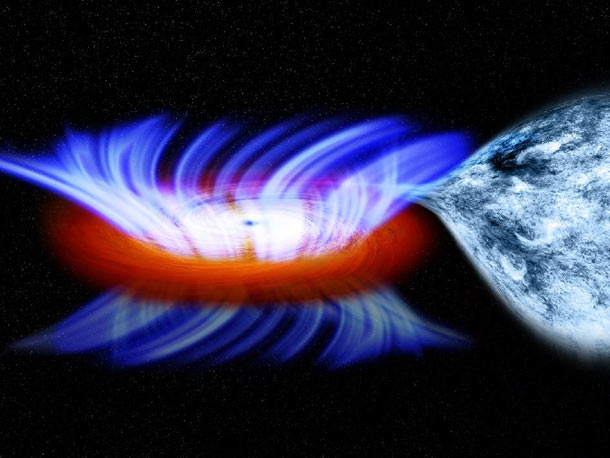Create a free profile to get unlimited access to exclusive videos, sweepstakes, and more!
Desktop Project Part 22: A black hole belches out a hurricane

[We're in the home stretch of my Desktop Project: going through all the pictures on my computer's desktop and posting one a day until they're gone. Only a few left now...]
This is the only one of my Desktop Project pictures that's not actually a picture: it's an illustration. It's still pretty neat:
[Click to Schwarzschildenate.]
This drawing shows the binary star IGR J17091â3624, which is actually a normal star in the clutches of a black hole. They orbit each other, and the fierce gravity of the black hole is drawing material off the other star. This matter doesn't fall straight into the black hole, however. Because the two stars orbit each other, the material coming off the normal star has some sideways velocity (technically, angular momentum) which causes it to spiral around the black hole and form a disk called the accretion disk.
This disk is hot. Very way incredibly yikes hot: probably something like 10 million degrees Celsius (27 million F). The heat comes from lots of forces including magnetism and plain old friction as particles rub against each other pretty violently before The Final Plunge.
Stuff that hot emits X-rays, and this binary is blasting them out. What's so very interesting is that astronomers studying this black hole found that something was absorbing X-rays from the disk. Their best guess is that this is vaporized iron blasting away from the disk in a kind of black hole wind, and it's hauling butt: the material is expanding at a speed upwards of 9300 km/sec -- that's 5800 miles per second, fast enough to cross the US in less than the tick of a watch. Want another unit? That means the wind is blowing at a brisk 0.03 times the speed of light!
I love black holes. They're many things, but one they aren't is subtle.
Another thing they are is ironic: although most people think of them as being able to suck down everything, including light, they power the most luminous objects in the Universe. This black hole probably is small, a few times the mass of the Sun. But much bigger ones exist, with millions or even billions of times the mass of the Sun. Those are in the centers of galaxies, and can have so much material falling into them and heating up that they can shine brighter than all the stars in the galaxy combined! It's not the black hole itself that's glowing, but it's the center, the engine, behind that raw fury.
And that wind may be more than bright: there's some evidence that the mighty gale from a galaxy's central black hole affects the overall state of the galaxy itself. It may be tied to the way stars form in the galaxy, and even the size of the galaxy itself. Mind you, even a black hole with a billion times the Sun's mass is still only as small fraction of a galaxy, which might have hundreds of billions of stars! So while you might think of something like that as a monster, it's actually more amazing to me that something so tiny can be so influential on such a huge scale.
Illustration credit: NASA/CXC/M.Weiss
Related Posts:
- Star eaten by a black hole: still blasting away
- S marks the spot
- A tiny galaxy that hides a big secret
- Black hole erupts in nearby galaxy



























